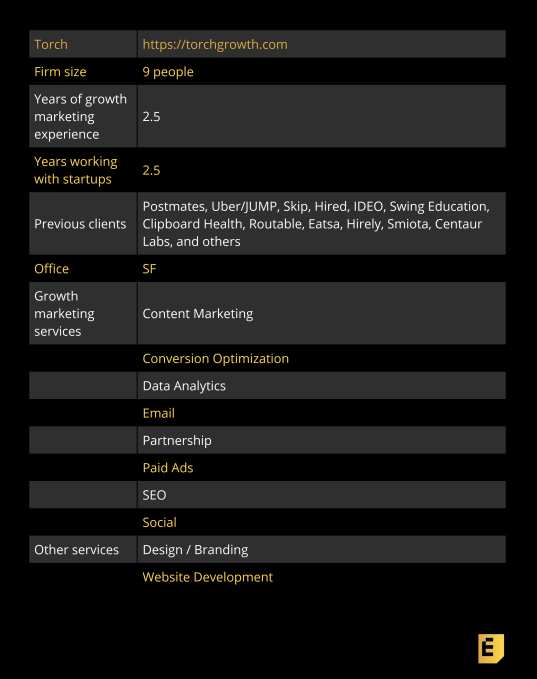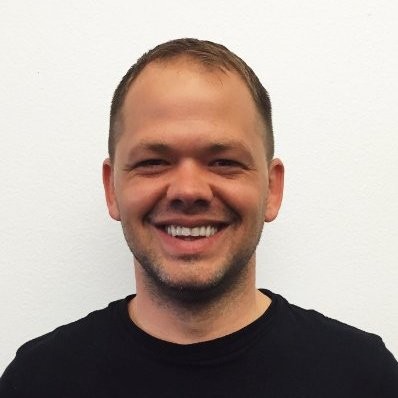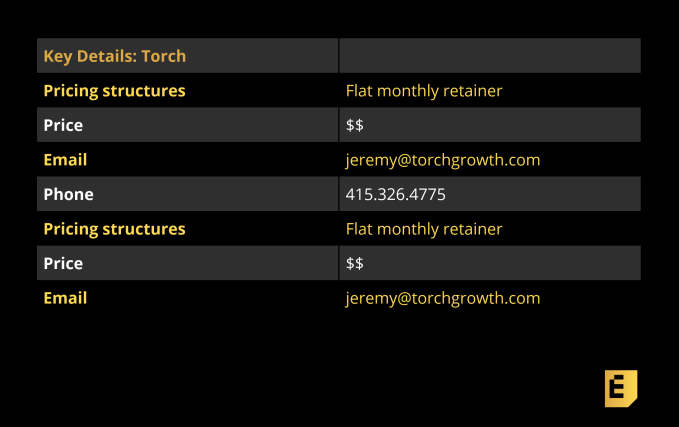CEO Jeremy OBriant never intended to create Torch, an agile growth marketing agency based in San Francisco. He started his career as a CPA, but after leading a growth team at Sidecar and running growth projects on his own, forming Torch was the most obvious thing to do. He now leads a team that implements “agile growth,” an iterative approach that involves setting clear goals and running smaller experiments over the course of monthly sprints. Learn more about their approach to growth, their ideal client, and more.
“Torch offers custom solutions to whatever you need. They are fast and deliver on what they promise. They are also scrappy and willing to try stuff to solve unique needs.” Head of Product in SF
Torch’s approach to growth
“We aim to be the thought leaders of Agile Growth. We didn’t invent the term, but we are certainly becoming the leading voice of the process in the growth marketing world. Agile simply means being able to move quickly and with ease. We start with clearly defined business goals and prioritize growth tactics based on the impact, cost, and efficiency. Then collaborate with growth teams to execute a handful of items in recurring growth sprints, typically on a monthly cadence.”
On their ideal client
“Our ideal partner has product-market fit, is redefining their category, and is ready to scale in a sustainable way. We are very strategic in the types of businesses we work with and steer clear of doing narrow prescriptive tactics. We love to collaborate with partners that are open to taking a fresh strategic look at their entire growth stack and embrace the agile approach to discover the right strategy for their unique situation.”

Below, you’ll find the rest of the founder reviews, the full interview, and more details like pricing and fee structures. This profile is part of our ongoing series covering startup growth marketing agencies with whom founders love to work, based on this survey and our own research. The survey is open indefinitely, so please fill it out if you haven’t already.
Interview with Torch CEO Jeremy OBriant

Yvonne Leow: Tell me about your background and how you became a growth marketer.
Jeremy OBriant: People are often surprised when I tell them I started my career as a CPA. I ended up working in the trenches on several M&A deals and heard lots of founding stories from entrepreneurs.
It was addicting to learn about the details of what it took to get the first few customers and scale. I was just enamored with early-stage companies and new I’d spend my career building them.
I went back to business school and my path to growth marketing quickly evolved. I took a fascinating digital marketing class taught by Troy Henikoff (MATH Venture Partners) that led to some growth-related internships and freelance projects.
Ultimately, I made my way to San Francisco and led a growth team at Sidecar, a very scrappy rideshare pioneer. In 2016 I joined General Motors/Cruise via the acquisition and in 2017 took a sabbatical and started Torch.
Torch itself was unintentional. I was experimenting with projects on the sabbatical and freelanced for a friend on the side to pay rent. I just kept saying ‘yes’ to other growth consulting opportunities and kept getting more and more interested in how challenging it is for companies. Soon there was a team, office, and long list of success stories and I realized Torch was exactly the project I should focus on.
Yvonne Leow: What’s Torch’s philosophy when it comes to growth marketing? How is agile growth different from a traditional growth marketing mindset?
Jeremy OBriant: We aim to be the thought leaders of Agile Growth. We didn’t invent the term, but we are certainly becoming the leading voice of the process in the growth marketing world.
Agile simply means being able to move quickly and with ease. We start with clearly defined business goals and prioritize growth tactics based on the impact, cost, and efficiency. Then collaborate with growth teams to execute a handful of items in recurring growth sprints, typically on a monthly cadence.
We now have thousands of hours of practice with the process and it has been an incredibly effective way to collaborate with our partners. The biggest reward is seeing it adopted by some of the internal growth teams we’ve worked with.
When the framework is applied in different scenarios, it is a great stress test and continually strengthens our version of it. Real-world use has been the best laboratory.
Yvonne Leow: Who’s your ideal client? How many do you take on at one time?
Jeremy OBriant: Our ideal partner has product-market fit, is redefining their category, and is ready to scale in a sustainable way. We are very strategic in the types of businesses we work with and steer clear of doing narrow prescriptive tactics. We love to collaborate with partners that are open to taking a fresh strategic look at their entire growth stack and embrace the agile approach to discover the right strategy for their unique situation.
We currently work with about 10 teams and have gotten much more selective with what we take on. We have an extremely high bar for quality and speed of execution and really are trying to grow in a sustainable way so that never gets compromised.
Yvonne Leow: What’s Torch’s process for on-boarding and working with partners?
Jeremy OBriant: Once we engage, we jump right in. The agile process is very collaborative in the beginning as we align on specific goals and prioritize the tactics we will tackle in the first sprint.
From there, the amount of interaction really depends. Most of the time we prefer to go in our hole for the month and put the focus towards execution.
Though sometimes we need to collaborate more closely with partners throughout the sprint. Either way, we’re often jamming on actual tactics within a week or two of engaging and report on progress in a monthly retrospective meeting.
Yvonne Leow: Does Torch focus on any particular industry/vertical? What’s interesting about that space compared to others?
Jeremy OBriant: Marketplace businesses are in my DNA from my days at Sidecar so many of our partners have some sort of two- or three-sided business — typically related to the on-demand economy, managed services, future of work, and mobility. They present a unique challenge because you have to balance targeting different personas (i.e. supply and demand) across geographies and be surgical in the way you scale.

Yvonne Leow: What are some growth marketing strategies that apply across that vertical?
Jeremy OBriant: There are so many! One that comes to mind is the high volume recruitment marketing we’ve done for several companies that target rideshare drivers, nurses, teachers, industrial workers, and other large workforce categories.
We’ve helped our partners recruit over 250,000 workers thus far and have gotten good at everything from growing organic applicant traffic to using chatbots to improve onboarding conversion. We’ve even built a few in-house software applications that give us an edge in this area.
There is a lot of cross-pollination that happens from the agency vantage point. When you rely solely on an internal team you often hit a local maximum on tactics and miss out on peripheral opportunities. We continue to learn across our partners and share the latest best practices we discover with the teams we work with.
Yvonne Leow: What’s the most frustrating thing that you see in growth marketing today? Why do you think it needs to change?
Jeremy OBriant: It is easy to grow fast nowadays, but that doesn’t mean it’s always done well. Haphazardly relying on paid channels without investing properly in organic, product, content, and other sustainable areas is a dangerous game if economic conditions change.
Growth absolutely needs to be a process that bridges all the core functions of the business and is continually monitored and improved. Something like 20% of GDP goes to marketing and advertising, and in our opinion, much of it is unnecessary and would be avoided if more businesses found ways to stretch their budgets further.
Yvonne Leow: What advice would you give to founders when it comes to growth?
Jeremy OBriant: There is no silver bullet. Building a sustainable engine of growth is often the sum of several tactics executed flawlessly and consistently with a methodological process. There’s also a compounding effect to concurrently running several growth tactics at once: the old 1+1=3 equation certainly applies.
It’s not just about optimizing your paid ads or showing up first in a Google search, it’s about the messaging on the landing page, the speed that it loads, the calls to action they see, the clusters of content that nurture them, the list is quite literally endless. The growth toolkit is broader than ever and the winners are the ones build a process to continually look across the landscape to optimize their unique customer journey.
Yvonne Leow: How long is each engagement? Do you work with partners on an ongoing or one-off basis?
Jeremy OBriant: We look to build long term partnerships. We’re still engaged with our very first partner and continually add more as we grow.
If we can’t find ways to add value over a long horizon there are typically more systemic issues to worry about. That said, if we do our job well, we expect our partners to eventually grow out of us as the company matures.
Yvonne Leow: What’s your payment structure and why did you choose that business model?
Jeremy OBriant: We’ve found the best way to work with partners is on a flat month-to-month retainer. For about the cost of a marketing manager, you get access to an entire team with deep domain expertise across the growth landscape, plus an entire toolkit of software tools and discounts we’ve accumulated. There is no commitment and we always tell our partners they should absolutely walk away if they are not getting a return on their investment.
That is different than most agencies that have minimum time commitments, vague hourly billing, and commissions on ad spend. I made a very conscious decision early on to do things differently and pass any discounts or ad commissions on to our partners.
Our model is predictable, transparent, and aligns incentives to maximize value for the business.
Yvonne Leow: How many people are on Torch’s team and what’s their background or expertise?
Jeremy OBriant: Currently, we have a regular team of eight with a much broader network of freelancers/partners with whom we regularly work with beyond that. We are truly full-stack (marketing, product, engineering) and are intentionally building a team with diverse expertise and unique backgrounds that make them exceptional in their domain.
As a services company, our team is our brand. We pay a ton of attention to making sure we are attracting and developing the right individuals that are deeply passionate about growth.
Yvonne Leow: Is there anything else you’d like to mention?
Jeremy OBriant: We love to chat growth with founders and growth teams. Even if you’re not in the market for an agency, we spend several hours a month doing growth jam sessions with early-stage companies. It gives us a fresh perspective and is genuinely rewarding to help good people discover how to grow their businesses better. Just reach out to us.
Founder Recommendations
“Diversified acquisition channels and reduced cost per user.” – Fahm Saeteurn, San Carlos, CA, VP of Product, Swing Education
“Rebranding of our company with new logo look and feel, website, content, blogging, job postings, and lead generation.” – Manju Kashi, Pleasanton, CA, CEO, Smiota
“Centralized data sets to optimize for ad buys. Decreased our CAC and expanded media mix to reach more prospects. Developed and executed our SEO, SEM and content strategy from scratch.” – Director of Marketing in SF
“They’ve helped develop our growth strategy and have done a lot of content marketing as well as strategies around finding new customer acquisition channels.” – CEO and Founder in SF
Torch was instrumental in our launching our scooter charger program. They owned our charger acquisition end-to-end, helped us identify bottlenecks in our onboarding funnel, all leading to a CAC well below our targets. I would decide to work with them again in a heartbeat. – Florent Crivello, SF, Product Manager, Uber
“Torch offers custom solutions to whatever you need. They are fast and deliver on what they promise. They are also scrappy and willing to try stuff to solve unique needs.” – Head of Product in SF
“We work with Torch in various capacities, primarily though in PPC advertising. They’ve helped us grow several of our partner startup companies in the Silicon Valley area and have become a very hyper-focused growth agency that specifically positions themselves as working with startups.” – Paul Kleen, Austin, TX, CEO, WeAdvertiseYourBusiness.com
“Delivered leads.” – President of Staffing Referrals in Denver, CO
“Led our marketing strategy during and post-YC, including ad optimization across channel/design.” – Tom Gellatly, Oakland, CA, Cofounder, VP of Engineering, Centaur Labs
